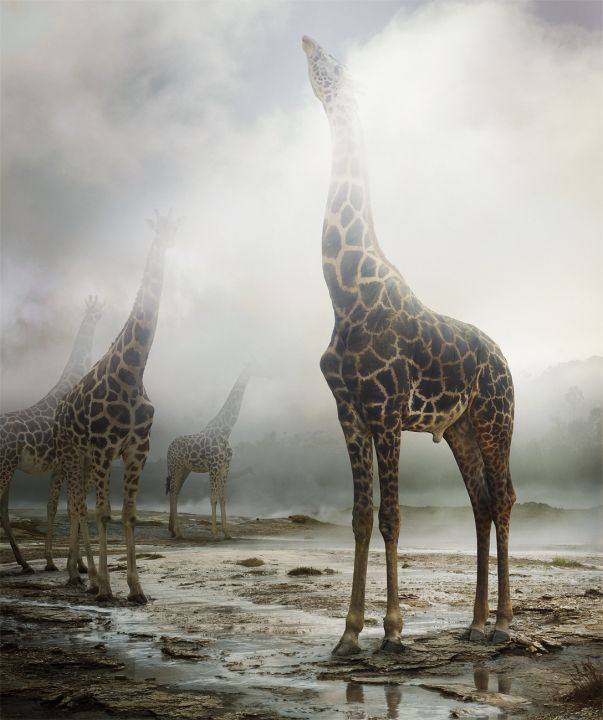
Simen Johan (b. 1973) initially drew attention in the early 90s by merging digital manipulation with traditional darkroom techniques. He has since developed a hybrid form of image-making, integrating candidly photographed animals and landscapes with a compositional structuring and conceptual intent typically associated with painting and cinema. Johan born in Kirkenes, Norway, was raised in Sweden and has been established in New York for over two decades.
Combining image elements that he photographed in a variety of international locations, Johan’s images reveal poetic and often unexpected relationships that speak to the illusory and multifaceted nature of existence. Stripes on a dazzle of Grévy’s zebras mesh with the fronds of geographically incongruent palms; jaguars in a tree are both defined and obscured by their spots and dappled sunlight; pigeons flock towards light like moths (or angels). Tensions between what is revealed and what is concealed, what is alluring and what is menacing, what is fact and what is fiction, both shape and unsettle the scenes. These amalgamations of sentiments, creatures, and environments are printed near life-size to mimic the scale of natural vision.
Growing up, Simen Johan wanted to become a filmmaker, inspired by directors such as Stanley Kubrick, David Cronenberg and David Lynch, whose movies transported him to “suspenseful, strange and psychologically-charged places that didn’t merely entertain, but also revealed complex truths about life, people and the world.” After studying film in Falun, Sweden, he moved to New York City in 1992 to study at the School of Visual Arts, a decision encouraged by his step grandfather and filmmaker Rod E. Geiger. The staggering costs of film production soon influenced him to change his field of study to photography.
“Photography to me was the next best thing. The still image too can have considerable narrative and symbolic power and – unlike film – in photography, I could do everything myself. Since the beginning I looked for ways to manipulate my photographs. Initially, I did so through various darkroom experiments and manual cut-and-paste collaging techniques, and then in my second year I discovered Photoshop.”
Johan’s interest in filmmaking is apparent in his work, where atmosphere, symbolism and emotion create drama and communicate meaning.
Simen Johan appreciates photography’s ability to capture candid moments and expressions, but finds that it can be an obstacle to imagination. Working digitally frees him to work more creatively, like a painter manipulating paint or a sculptor manipulating clay. He photographs most of his material candidly, because “when you’re dealing with animals and nature, you’re really only gonna get what you’re gonna get. Animals never look how you expect them to look or do what you want them to do, and there’s no controlling nature.” He travels extensively and photographs landscapes and animals wherever he can find them: in zoos, safari parks, farms and the wild. Over the years he’s built a wide-ranging image library that provides the building blocks for his composites.
Ideas emerge from intuitive experimentation, but once he better understands what he wants, things get more cerebral. For instance, when he photographed zebras at a zoo in California he became interested in the way the stripes of one zebra interacted with stripes of another, creating an optical illusion. An image idea didn’t crystalize though, until a few years later, when his experimentation led him to place the zebras into a tropical landscape he had photographed in Bali. He discovered that the palm leaves in the background, when lit by the sun, created stripes as well, thus camouflaging the zebras.
“I liked the artificial logic happening, where the zebras are camouflaged by incongruent foliage as if that’s why zebras are striped. In reality they’re plains animals and one theory is that they’re striped to confuse insects and predators, so the image shifts the logic. Reality is a bit like that. Things make sense until we start questioning them and realize that they’re not what they appear.”
Johan went to Florida to photograph more palm trees to complete the scene.
“Camouflage is a recurring theme in my work. It’s nature’s way of confusing the things we see. We tend to look to nature for authenticity, but even here we encounter illusion– from camouflage to colors and smells that confuse our senses. Nature caters well to our survival, but it’s objective is not for us to see or think clearly.”
“The title of this body of work, Until the Kingdom Comes”, he explains “refers less to the kingdoms of the bible and natural world, and more to the human fantasy that one day, in some way, life will come to a blissful resolution. The answers to who we are and what we’re doing in this world will come to light and validate our existence. In a reality where understanding is never total, I depict ‘living’ as an emotion-driven experience, engulfed in uncertainty, desire and illusion.”